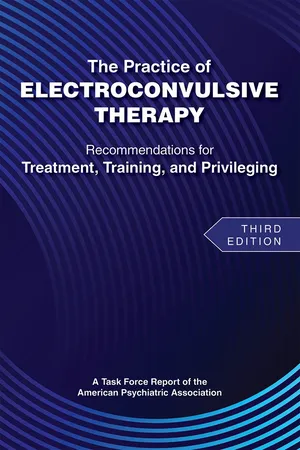
- 486 pages
- English
- ePUB (mobile friendly)
- Available on iOS & Android
About this book
Two decades of advances related to electroconvulsive therapy (ECT) prompted the American Psychiatric Association Task Force on Electroconvulsive Therapy to update the recommendations for its use. This volume is the result of that work.
This third edition of The Practice of Electroconvulsive Therapy—the first since 2001—captures the body of knowledge on the safety, efficacy, and practice of ECT accumulated over the past 20 years, including more than 1, 100 new literature citations. New features of this book include
• Chapters on detecting and managing adverse effects, including cognitive side effects, and assessing treatment outcomes to support measurement-based care• A discussion of approaches to optimize response and reduce relapse, including use of maintenance ECT, and guidance for management of patients not responding to an acute ECT course• An overview of the 2018 United States Food and Drug Administration's reclassification of ECT devices and its implications for clinical practice• A chapter on other neuromodulation techniques, including transcranial magnetic stimulation, vagus nerve stimulation, deep brain stimulation, and emerging neuromodulation approaches
Like its predecessors, this edition provides comprehensive information on staffing, assessment, and preparation for ECT; informed consent; anesthestic management; stimulus electrode placement; electrical stimulus parameters and dosing; seizure monitoring; and much more. The use of ECT in special circumstances—including in patients with catatonia, in children and adolescents, and during pregnancy—is also discussed.
With detailed information on concurrent medications and medical comorbidities that may require modifications to treatment, as well as indications for the use of ECT, this book is an indispensable guide to state-of-the-art ECT practice.
Frequently asked questions
- Essential is ideal for learners and professionals who enjoy exploring a wide range of subjects. Access the Essential Library with 800,000+ trusted titles and best-sellers across business, personal growth, and the humanities. Includes unlimited reading time and Standard Read Aloud voice.
- Complete: Perfect for advanced learners and researchers needing full, unrestricted access. Unlock 1.4M+ books across hundreds of subjects, including academic and specialized titles. The Complete Plan also includes advanced features like Premium Read Aloud and Research Assistant.
Please note we cannot support devices running on iOS 13 and Android 7 or earlier. Learn more about using the app.
Information
Table of contents
- Cover Page
- Title Page
- Copyright Page
- Contents
- Contributors
- 1 Introduction
- 2 Indications for the Use of Electroconvulsive Therapy
- 3 Staffing
- 4 Location, Equipment, and Supplies
- 5 Documentation
- 6 Education and Training
- 7 Privileging
- 8 Pre-ECT Evaluation of the Patient
- 9 Use of Electroconvulsive Therapy in Special Populations
- 10 Consent for Electroconvulsive Therapy
- 11 Preparation of the Patient for Electroconvulsive Therapy
- 12 Anesthesia
- 13 Use of Medications During the Course of Electroconvulsive Therapy
- 14 The Electrical Stimulus and Placement of Stimulus Electrodes
- 15 Seizure Monitoring During ECT
- 16 Postictal Recovery Period
- 17 Evaluation of Outcome
- 18 Frequency and Number of Treatments
- 19 General Adverse Events
- 20 Cognitive Side Effects of Electroconvulsive Therapy
- 21 Management of Prolonged, Missed, Abortive, or Inadequate Seizures
- 22 Lack of Response to the Acute Electroconvulsive Therapy Course
- 23 Management of Patients Following an Electroconvulsive Therapy Course
- 24 New and Emerging Neuromodulation Techniques
- Appendix
- References
- Index
- Color Gallery